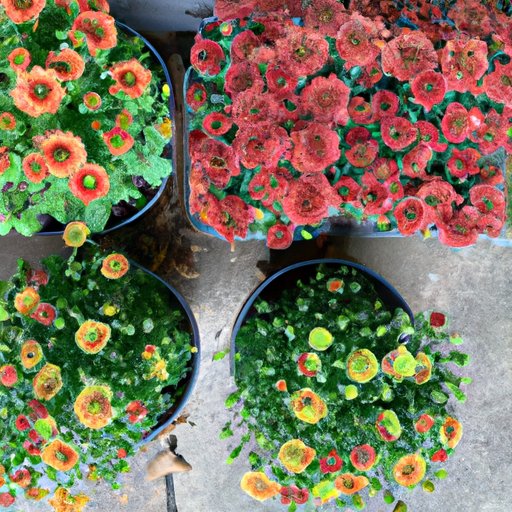Introduction
If you love gardening, chances are you have a special place in your heart reserved for mums. These beautiful, colorful autumn flowers are a staple in many outdoor spaces and can bring joy and beauty to any garden bed or container. But caring for mums properly can be challenging, especially for new gardeners. In this article, we’ll provide tips and advice on how to care for your mums successfully and keep them healthy and happy all season long.
Five Tips for Keeping Your Mums Healthy and Happy All Season Long
Mums need to be cared for properly to ensure their health and beauty. Here are some tips to help you keep your mums healthy and happy.
Tip #1: Watering
Mums need frequent and consistent watering throughout the growing season to keep them healthy. Water them deeply whenever the soil feels dry to the touch, and make sure the soil in the pot or bed drains well so that water does not accumulate around the roots. Avoid over-watering, as this can encourage root rot or mold.
Tip #2: Fertilizing
Fertilizing your mums regularly can help them grow healthy and strong. Use a balanced fertilizer with a higher amount of phosphorus than nitrogen to encourage blooming. Apply the fertilizer to the soil around the mums every two weeks, or follow the instructions on the package.
Tip #3: Pruning
To keep your mums looking their best, it is important to prune them regularly. Pinch off any dead or wilted blooms, as well as any yellowed or damaged leaves. This can encourage more blooms to form and improve air circulation around the plant, which can help prevent disease.
Tip #4: Protecting from pests and diseases
Mums are susceptible to pests and diseases, so it is important to protect them. Use insecticidal soap or horticultural oil to control pests like aphids, spider mites, and whiteflies. Keep an eye out for any signs of disease, such as powdery mildew or leaf spot, and treat them promptly to prevent the spread of infection.
Tip #5: Keeping mums in containers vs. planting in the ground
Mums can be grown either in containers or directly in the ground. Growing them in containers allows you to move them around to various locations in your garden or bring them indoors when the weather gets cold. Planting them directly in the ground can add a pop of color to your outdoor garden beds and provide a more natural environment for the plants to grow.
The Ultimate Guide to Overwintering Mums
To ensure your mums survive the winter and return healthy next year, it is essential to prepare them properly. In this section, we’ll give you a step-by-step guide, including what to do and when to do it.
Explanation of why it’s important to prepare mums for winter
Mums are perennials, which means they will come back year after year under the right conditions. However, they are also sensitive to cold temperatures and harsh winter winds, which can damage or kill them. Preparing your mums for winter can help them survive and thrive next year.
Step-by-step guide to overwintering mums
Here’s how to overwinter your mums:
- Stop fertilizing your mums by August 15th to allow them to focus on building up their root systems rather than their blooms.
- Stop pruning your mums by September 15th to allow the plant to produce adequate wood for winter hardiness.
- Stop watering your mums by early October to allow them to acclimate to winter dormancy.
- Once the first hard frost hits, cut the stems of your mums back to around 4-6 inches.
- Cover the remaining stems with 4-6 inches of mulch or straw to protect them from extreme cold.
How to Divide Mums: A Step-by-Step Guide
Dividing mums is an important aspect of caring for them, both for aesthetic reasons and to promote their health and longevity. Here’s a step-by-step guide on how to do it:
Importance of dividing mums
Mums have a tendency to become overgrown and develop dead or unhealthy sections. Dividing mums is an effective way to prevent overcrowding and keep the plants healthy and blooming.
Step-by-step guide on how to divide mums
Follow these steps to divide your mums:
- Choose a healthy mum plant that has grown in its spot for at least two years.
- Water the plant well the day before you plan to divide it.
- Use a sharp spade or garden knife to dig up the entire plant.
- Shake off any excess soil and separate the plant into smaller, healthy sections.
- Trim the roots of each divided section and replant them immediately.
Tips on when to divide mums
The best time to divide mums is in the spring or fall, after blooming has finished. Choosing one of these times of year will give your mum the best chance of thriving after being divided.
Mum Maintenance: What to Do When Your Plants Look Sick
Even with proper care, mums can fall victim to pests and diseases. In this section, we’ll discuss common problems that affect mums, how to identify them, and what you can do to fix them.
Discuss common pests and diseases that affect mums
Mums can fall prey to pests such as aphids, spider mites, and whiteflies, as well as diseases like powdery mildew, leaf spot, and root rot. Understanding the signs and symptoms of these conditions can be helpful in identifying and treating them.
Tips on identifying problems and how to fix them
If you notice your mums looking unwell, here are a few tips to help identify the problem and find a solution:
- Check the plant for discolored leaves or blooms, which may indicate disease or infestation.
- Treat infestations with insecticidal soap or horticultural oil.
- To prevent the spread of disease, trim any affected parts of the plant and dispose of them immediately.
- The application of fungicides can help control fungal diseases such as powdery mildew or leaf spot.
Design Ideas for Using Mums in Your Garden Beds and Containers
Mums can be used to add color and texture to any outdoor space. Here are some creative design ideas that showcase these beautiful flowers.
Explanation of how mums can be used in outdoor decor
Mums can be used in garden beds, containers, or even as centerpieces on your patio table. Their bright, colorful blooms provide a beautiful contrast to fall foliage, pumpkins, and other autumn decorations.
Creative designs or arrangements that feature mums
- Combine your mums with pumpkins and gourds for a festive fall display.
- Mix mums with other flowers, such as asters or pansies, to create a dynamic and colorful garden bed.
- Plant mums in containers of various sizes and colors and group them together for a beautiful display.
Growing Mums from Seed: Challenges and Rewards
Growing mums from seed can be challenging, but it is also rewarding. Here are some tips for germinating and nurturing mum seeds until they mature into blooming plants.
Explanation of why growing mums from seed can be rewarding
Growing mums from seed can be a rewarding experience, as it allows you to watch the process of the plant’s growth from start to finish. It also provides an opportunity to save money over purchasing fully grown plants.
Step-by-step guide for germinating and nurturing mum seeds until they mature into blooming plants
Here are some tips for growing mums from seed:
- Start seeds indoors in soilless growing mix around 8 to 10 weeks before your last frost date.
- Keep the soil consistently moist but not overly wet, and provide plenty of bright light.
- Transplant seedlings to individual pots once they have grown their second set of true leaves.
- Gradually harden off plants by exposing them to increasing amounts of sunlight, wind, and cooler temperatures as they grow.
- Transplant mature plants to your garden bed or container as soon as they become well established

The History and Symbolic Meaning of Mums
Mums have a fascinating history and are associated with various meanings around the world. Here’s a brief overview of their story.
Overview of the history and significance of mums
Mums are native to China, where they were cultivated over 2,500 years ago. They were highly valued and were featured in Chinese art and literature. Over time, mums were brought to other parts of the world, including Japan and Europe, where they gained popularity as ornamental plants.
Discussion of the origin of the name, use of mums in ancient cultures, and various meanings attached to these flowers today
Mums got their name from the Greek word “chrysanthos,” meaning “golden flower”. In ancient cultures, mums were thought to have healing powers, and were used to treat various ailments. They are also associated with death and the afterlife, and are often used in funeral arrangements. Today, mums are grown and admired around the world for their beauty, elegance, and versatility.
Conclusion
In conclusion, taking care of mums is crucial to maintain their beauty and promote their health and longevity. By following these tips and guidelines, you can ensure that your mums bloom brightly and remain healthy all season long. Whether you’re starting with seeds or full-grown plants, mums are a joy to grow and admire, and are sure to bring beauty and elegance to your outdoor spaces.
